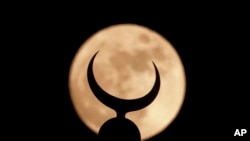Nature lovers will have their fill of celestial treats in January with two supermoons, a blue moon and a total lunar eclipse gracing the night sky.
The first supermoon of 2018 will occur on the evening of New Year's Day into the night of Jan. 2.
A supermoon occurs when a full moon is at its closet orbital point to Earth, appearing up to 30 percent brighter and up to 14 percent larger than when the moon is at its furthest point in its orbit.
Another supermoon will follow on Jan 31, passing by Earth about 26,500 kilometers (16,466 miles) closer than usual.
Those two supermoons are part of a trilogy of supermoons that began on Dec. 3. Forecasters say it is rare to have two supermoons back to back, let alone three in a row.
Scientists say the best time to view a supermoon is right after moonrise and before sunrise, when the moon is sitting on the horizon. This makes the moon look even larger compared to other objects appearing against the night sky, such as buildings and trees.
The last full moon of January is also known as a blue moon because it is the second full moon to occur during a single month.
The Jan. 31 moon will also feature a total lunar eclipse, with totality visible from western North America across the Pacific to eastern Asia. The moon will appear to be red, and is nicknamed a blood moon, because it lines up perfectly with the Earth and sun such that the Earth’s shadow totally blocks the sun’s light. The moon loses the brightness normally caused by the reflection of the sun's light and takes on an eerie, reddish glow.
The lunar eclipse will make the Jan. 31 moon a blood moon, a blue moon and a supermoon all at the same time.
Unlike a solar eclipse, a lunar eclipse is safe to view with the naked eye, so there is nothing to fear if you are captivated for a long stretch by the night sky.









